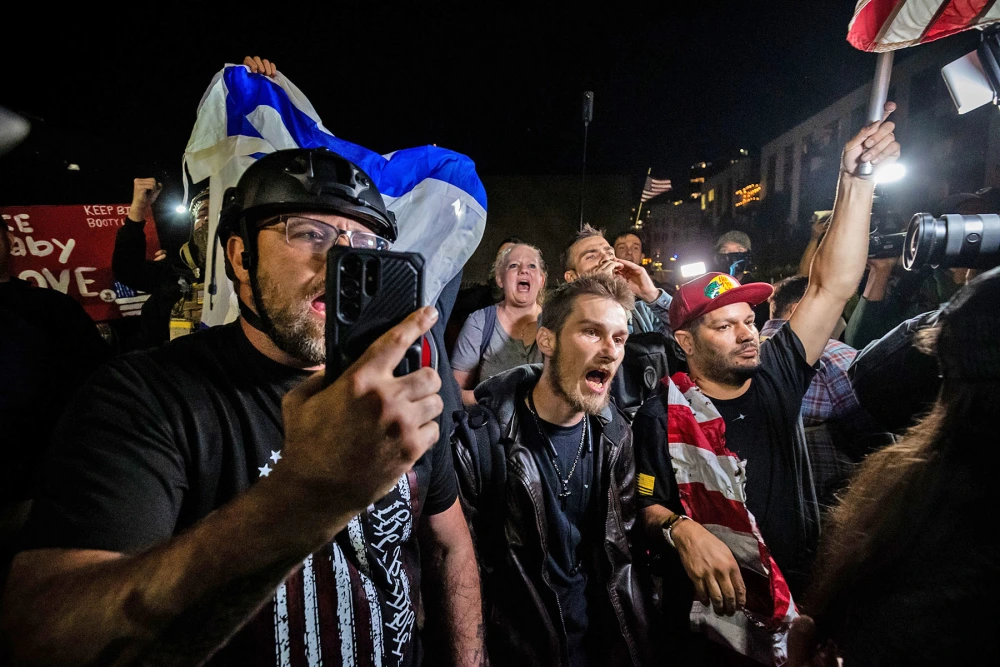PORTLAND, Ore. — As nightly protests against Immigration and Customs Enforcement (ICE) continue in Portland, Oregon, the demonstrations have drawn not only local activists but also a wave of right-wing influencers eager to document — and at times confront — the movement.
What began as local resistance to federal immigration enforcement has now evolved into a national spectacle, amplified by social media and political polarization. Conservative media figures, podcasters, and commentators have flooded the city, turning Portland’s protest zone into a stage for the ongoing culture war.
From Jail Cell to the White House
Few stories illustrate the strange dynamic better than that of Nick Sortor, a 27-year-old MAGA-aligned influencer with 1.2 million followers on X (formerly Twitter).
Also Read
Last Thursday, Sortor was arrested in Portland after clashing with demonstrators outside the ICE facility. Police booked him on suspicion of disorderly conduct, but prosecutors declined to file charges, citing insufficient evidence to prove a crime beyond a reasonable doubt.
Just six days later, Sortor’s fortunes reversed dramatically — he was invited to the White House, seated just feet away from former President Donald Trump during a livestreamed roundtable about the protests.
“It was not fun sitting in that jail, but I’m glad to see what has come of it,” Sortor told Trump during the broadcast.
The event underscored how MAGA influencers and the Trump administration have become symbiotic: the influencers provide real-time, emotion-driven coverage of protests, while Trump amplifies their narratives to his base.
The Rise of the Right-Wing Protest Correspondent
Over the past two weeks, at least a dozen conservative journalists and influencers have arrived in Portland, including reporters from The Post Millennial, The Blaze, and Turning Point USA’s Frontlines project.
“This is now a full-blown information war,” said Jonathan Choe, a Seattle-based reporter for Turning Point. “Being on the front lines is more important than ever.”
Choe joined Sortor at the White House event alongside fellow conservative media figures Katie Daviscourt, Benny Johnson, and Andy Ngo — all of whom have made names for themselves by covering protests from an overtly pro-Trump perspective.
A Growing and Tense Scene
Protests outside Portland’s ICE facility have taken place almost daily since June, usually involving several dozen demonstrators gathered on a single city block south of downtown. The protests grew in intensity after Trump’s September 27 announcement that he wanted to deploy National Guard troops “with full force” to quell unrest.
While mostly peaceful, the gatherings have occasionally led to scuffles between protesters, counterprotesters, and federal officers. Portland Police say they have made over 40 arrests since June, while federal prosecutors have filed 31 federal cases, including several involving alleged assaults on officers.
One protester, dressed in an inflatable frog costume, has become a symbol of absurdist defiance — a counter-image to federal descriptions of Portland as “war-torn.”
Police and Influencers at Odds
Portland police officials have expressed frustration with the influx of self-described “citizen journalists,” accusing some of provoking confrontations rather than simply documenting them.
In a recently released internal email, Sgt. Andrew Braun wrote that several right-wing influencers repeatedly inserted themselves into volatile situations near the ICE facility:
“Despite repeated advice from officers to stay away from the ICE crowd, they constantly return and antagonize the protesters until they are assaulted or pepper sprayed,” Braun said.
Among those mentioned was Katie Daviscourt, a writer for The Post Millennial, who later said she was hit in the face during a protest and criticized police on X for failing to protect her.
Portland Police Chief Bob Day acknowledged that social media has intensified tensions. “Their reach is significant,” he said. “They’re going where they can get views and shape perception. We’re just trying to uphold the law.”
Police spokesperson Mike Benner added that the bureau has no credentialing system for journalists, meaning independent reporters and influencers are treated the same as mainstream media. “We respect everyone’s right to document events,” he said, “but they must comply with lawful orders.”
At the White House: Mutual Admiration
The administration’s embrace of these influencers was on full display at the White House roundtable. Trump, joined by Homeland Security Secretary Kristi Noem, Attorney General Pam Bondi, and FBI Director Kash Patel, praised Sortor and Daviscourt for their reporting.
Trump even referred to a viral video where Sortor confronted protesters and rescued a burning American flag, suggesting it might warrant a federal investigation — despite Supreme Court rulings protecting flag burning as free speech.
“Nick, I saw you on television. Great job,” Trump reportedly wrote in a note shared by Sortor on X. “We are behind you 100%.”
Clashes on the Streets — and Online
The influencers’ presence has not been limited to filming. Videos posted on X show Sortor and others walking through protest encampments, arguing with demonstrators, and waving flags.
In one clip, Sortor declares, “I’m going to walk through. I want to give a tour of the camp,” before pushing past protesters blocking his path. In another, he retrieves a burning flag.
Podcaster Matt Tardio has even proposed a “Patriot March” through the protest camp, calling it a show of strength against “Antifa.”
Divided Perceptions and Political Stakes
While right-wing media portrays Portland as a lawless war zone, local and independent outlets have painted a starkly different picture.
An Oregonian fact-check published last week noted that Portland Fire & Rescue has responded to just four small fires near the ICE facility since June, and the last recorded bombing in the city occurred in 2008.
Public opinion remains deeply split. A New York Times/Siena poll found that 52% of voters disapprove of Trump’s handling of immigration, while 46% approve.
An Information War With Real Consequences
For the influencers, Portland has become a backdrop for the larger narrative of America’s political divide — a place where cameras roll, clips go viral, and ideology meets spectacle.
Julio Rosas, a correspondent for The Blaze who has covered protests nationwide, said the camaraderie among right-wing reporters helps them navigate the hostility they face.
“We’re often out there on our own,” Rosas said. “It’s good to have someone to watch your back.”
But even he admitted it’s a taxing assignment.
“Who wants to spend hours outside where people are angry?” he said. “Still, it’s important to show the world what’s happening — because this is where the story of America is playing out.”
For now, Portland remains both a protest zone and a media battlefield — where cameras, convictions, and competing truths continue to collide under the glare of national attention.












